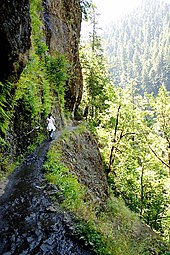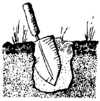Hiking: Difference between revisions
| Line 89: | Line 89: | ||
{{Commons+cat|Hiking}} |
{{Commons+cat|Hiking}} |
||
* {{dmoz|Recreation/Outdoors/Hiking|Recreation: Outdoors: Hiking}} |
* {{dmoz|Recreation/Outdoors/Hiking|Recreation: Outdoors: Hiking}} |
||
* [http://www.hikingsanfrancisco.com/ San Francisco Hiking Community] |
|||
{{Adventure travel}} |
{{Adventure travel}} |
||
Revision as of 21:35, 11 September 2010
This article needs additional citations for verification. (May 2008) |

Hiking is an outdoor activity which consists of walking in natural environments, often on hiking trails. It is such a popular activity that there are numerous hiking organizations worldwide. The health benefits of different types of hiking have been confirmed in studies.[1] The word hiking is understood in all English-speaking countries, but there are differences in usage.
Related terms
In the United States and United Kingdom, hiking refers to cross-country walking of a longer duration than a simple walk and usually over terrain where hiking boots are required.[2] A day hike refers to a hike that can be completed in a single day, often applied to mountain hikes to a lake or summit, but not requiring an overnight camp, in which case the term backpacking is used. Bushwhacking specifically refers to difficult walking through dense forest, undergrowth, or bushes, where forward progress requires pushing vegetation aside. In extreme cases of bushwhacking where the vegetation is so dense that human passage is impeded, a machete is used to clear a pathway. Australians use the term bushwalking for both on- and off-trail hiking. New Zealanders use tramping (particularly for overnight and longer trips), walking or bushwalking. Multi-day hiking in the mountainous regions of India, Nepal, North America, South America, and in the highlands of East Africa is also called trekking; the Dutch refer to trekking also. Hiking a long-distance trail[3] from end-to-end is also referred to as trekking and as thru-hiking in some places, for example on the Appalachian Trail (AT) or Long Trail (LT) in Vermont. The Long Trail is the oldest long-distance hiking trail in the United States.

Comparison with other forms of touring
Hiking is one of the fundamental outdoor activities on which many others are based. Many beautiful places can only be reached overland by hiking, and enthusiasts regard hiking as the best way to see nature. Hikers see it as better than a tour in a vehicle of any kind (or on an animal; see horseback riding) because the hiker's senses are not intruded upon by distractions such as windows, engine noise, airborne dust and fellow passengers. Hiking over long distances or over difficult terrain requires both the physical ability to do the hike and the knowledge of the route and its pitfalls.
Environmental impact
Hikers often seek beautiful natural environments in which to hike. These environments are often fragile: hikers may accidentally destroy the environment that they enjoy. While the action of an individual may not strongly affect the environment, the mass effect of a large number of hikers can degrade the environment. For example, gathering wood in an alpine area to start a fire may be harmless if done once (except for wildfire risk). Years of gathering wood, however, can strip an alpine area of valuable nutrients.[4] Generally, protected areas such as parks have regulations in place to protect the environment. If hikers follow such regulations, their impact can be minimized.[4] Such regulations include forbidding wood fires, restricting camping to established camp sites, disposing or packing out faecal matter, imposing a quota on the number of hikers per mile.
Many hikers espouse the philosophy of Leave No Trace: hiking in a way such that future hikers cannot detect the presence of previous hikers. Practitioners of this philosophy obey its strictures, even in the absence of area regulations. Followers of this practice follow strict practices on dealing with food waste, food packaging, and alterations to the surrounding environment.

Human waste is often a major source of environmental impact from hiking.[4] These wastes can contaminate the watershed and make other hikers ill. Bacterial contamination can be avoided by digging 'catholes' 10 to 25 cm (4 to 10 inches) deep, depending on local soil composition and covering after use. If these catholes are dug at least 60 m (200 feet) away from water sources and trails, the risk of contamination is minimized. Many hikers warn other hikers about the location of their catholes by marking them with sticks stuck into the ground.[citation needed]
Protecting the trails and nature areas may be taken further with the idea of taking out more than you brought in. If every responsible hiker took away some of the garbage left by others, as well as their own, trails and nature areas would gradually become pristine.
Sometimes hikers enjoy viewing rare or endangered species. However, some species (such as martens or bighorn sheep) are very sensitive to the presence of humans, especially around mating season. To prevent adverse impact, hikers should learn the habits and habitats of endangered species.
There is one situation where an individual hiker can make a large impact on an ecosystem: inadvertently starting a wildfire. For example, in 2005, a Czech backpacker burned 7% of Torres del Paine National Park in Chile by knocking over an illegal gas portable stove.[5] Obeying area regulations and setting up cooking devices on designated areas (or if necessary on bare ground) will reduce the risk of wildfire.
Hazards

Hiking may produce threats to personal safety. These threats can be dangerous circumstances while hiking and/or specific accidents or ailments. Diarrhea has been found to be one of the most common illness afflicting long-distance hikers in the United States[6]. (See Wilderness acquired diarrhea.)

Dangerous hiking circumstances include losing the way, inclement weather, hazardous terrain, or exacerbation of pre-existing medical conditions. Specific accidents include metabolic imbalances (such as dehydration or hypothermia), topical injuries (such as frostbite or sunburn), attacks by animals, or internal injuries (such as ankle sprain).
Hikers often propose a set of behavioral prescriptions to minimize these threats. A well-known example of such a set of prescription is the Ten Essentials.
Attacks by humans are also a reality. There are organizations that promote prevention, self defense and escape. The cell phone and GPS devices are used in some organizations.
In various countries, borders may be poorly marked. It is good practice to know where international borders are. Many nations, such as Finland, have specific rules governing hiking across borders.[7]
See also
- Hiking equipment
- List of long-distance footpaths
- Nordic Walking
- Swimhiking
- Ten essential items of gear
- Trek
Types
- Backpacking – also known as trekking, a multi-day, often arduous hike especially in mountainous regions
- Dog hiking – hiking with dogs
- Freehiking - hiking while unclothed, also hiking off-trail
- Hillwalking - a British term for hiking in hills or mountains
- Nordic Walking - Fitness walking with poles
- Llama hiking
- Scrambling - "non-technical" rock climbing or mountaineering OR "technical" hiking
- Thru-hiking – hiking a trail from end to end in one continuous hike (people may end to end a trail, but in section hikes)
- Ultralight backpacking
- Waterfalling – AKA waterfall hunting and waterfall hiking is hiking with the purpose of finding and enjoying waterfalls
- Dayhiking
- Heli Hiking- Using helicopters to access remote areas otherwise inaccessible
- Bushwhacking- A North American term for hikers and cross-country skiers who make their own trails.
Trails
Related activities
- Cross-country skiing - often the equivalent of hiking in snowy lands during wintertime
- Fell running - An English and Welsh sport of running over rough mountainous ground, often off-trail. Known as Hill running in Scotland and Ireland. Similarities exist with Mountain running popular overseas, but also many differences.
- Geocaching – outdoor treasure-hunting game
- Orienteering – running sport involving navigation with a map and compass
- River trekking
- Rogaining – sport of long distance cross-country navigation
- Trail blazing
References
- ^ http://www.miller-mccune.com/health/for-good-health-take-a-hike-796
- ^ Colorado Mountain Club: More than a great hiking club...
- ^ http://www.longtrailhiking.info/
- ^ a b c Cole, David. "Impacts of Hiking and Camping on Soils and Vegetation: A Review" (PDF).
{{cite journal}}: Cite has empty unknown parameter:|coauthors=(help); Cite journal requires|journal=(help) Cite error: The named reference "impact" was defined multiple times with different content (see the help page). - ^ Chilean park recovering from fire
- ^ Boulware DR, et al. (2003), “Medical Risks of Wilderness Hiking”, Am J Med, 114(4):288-93.
- ^ http://www.outdoors.fi/page.asp?Section=5801
